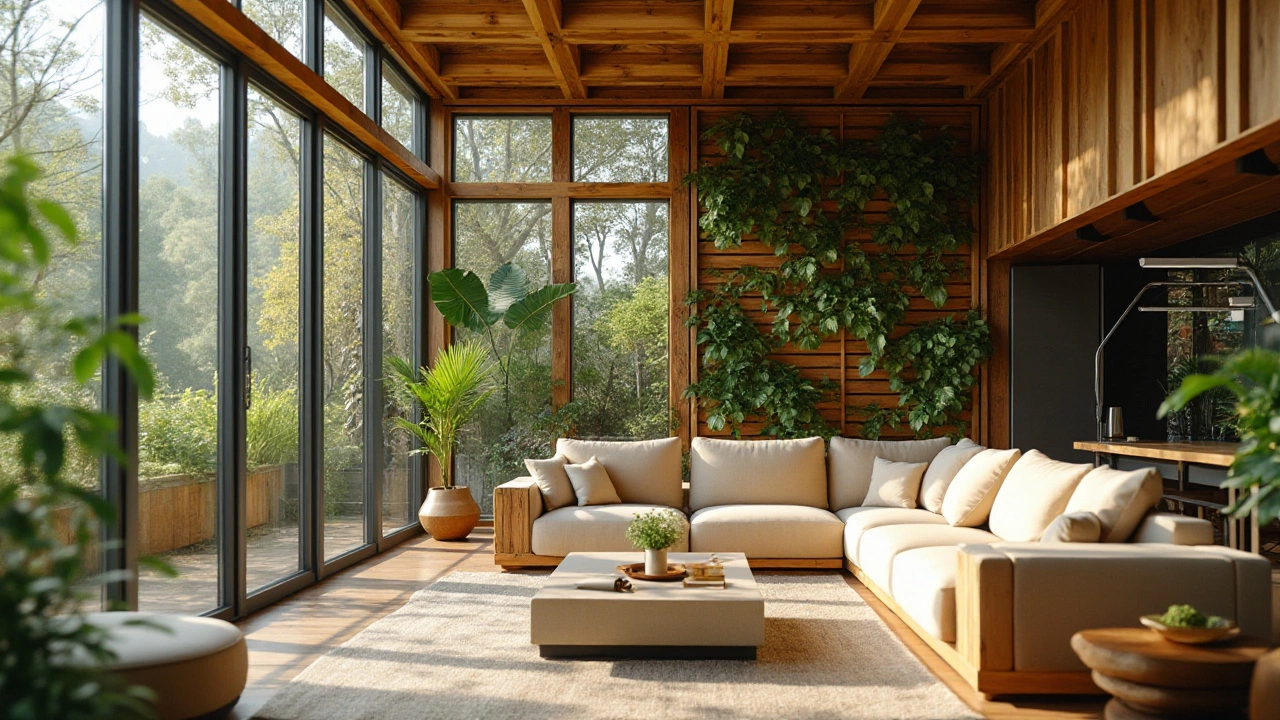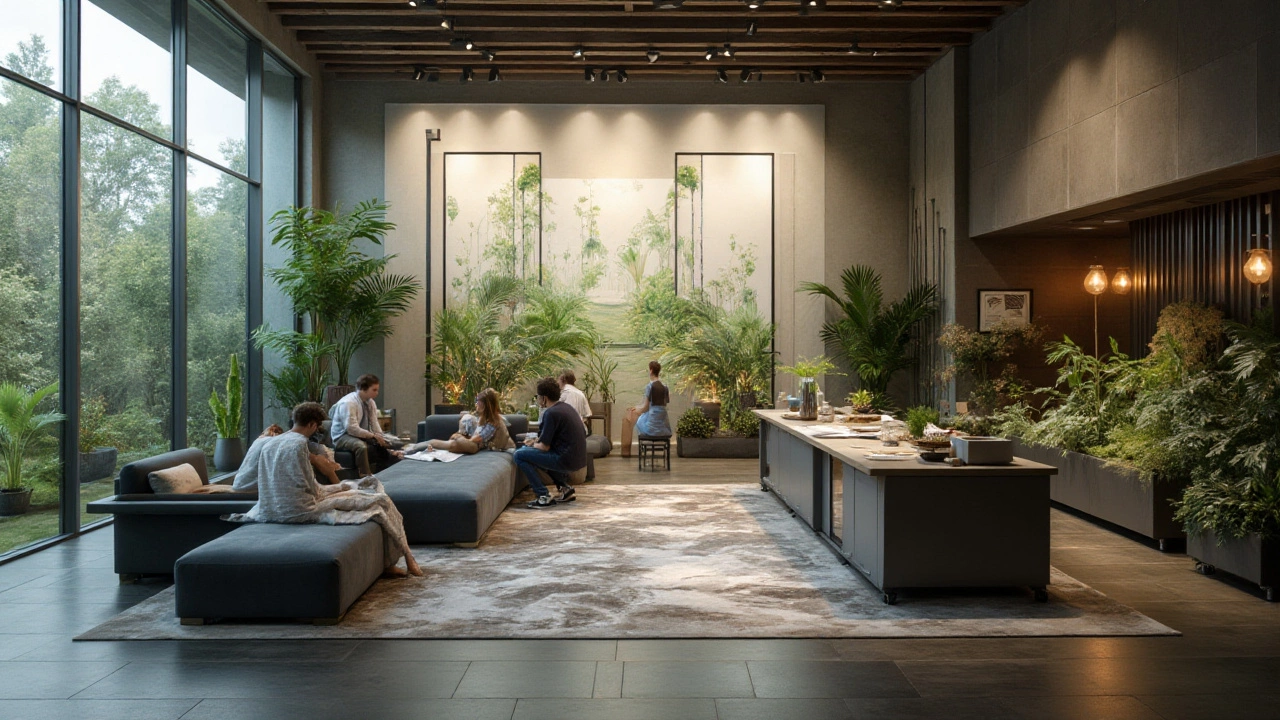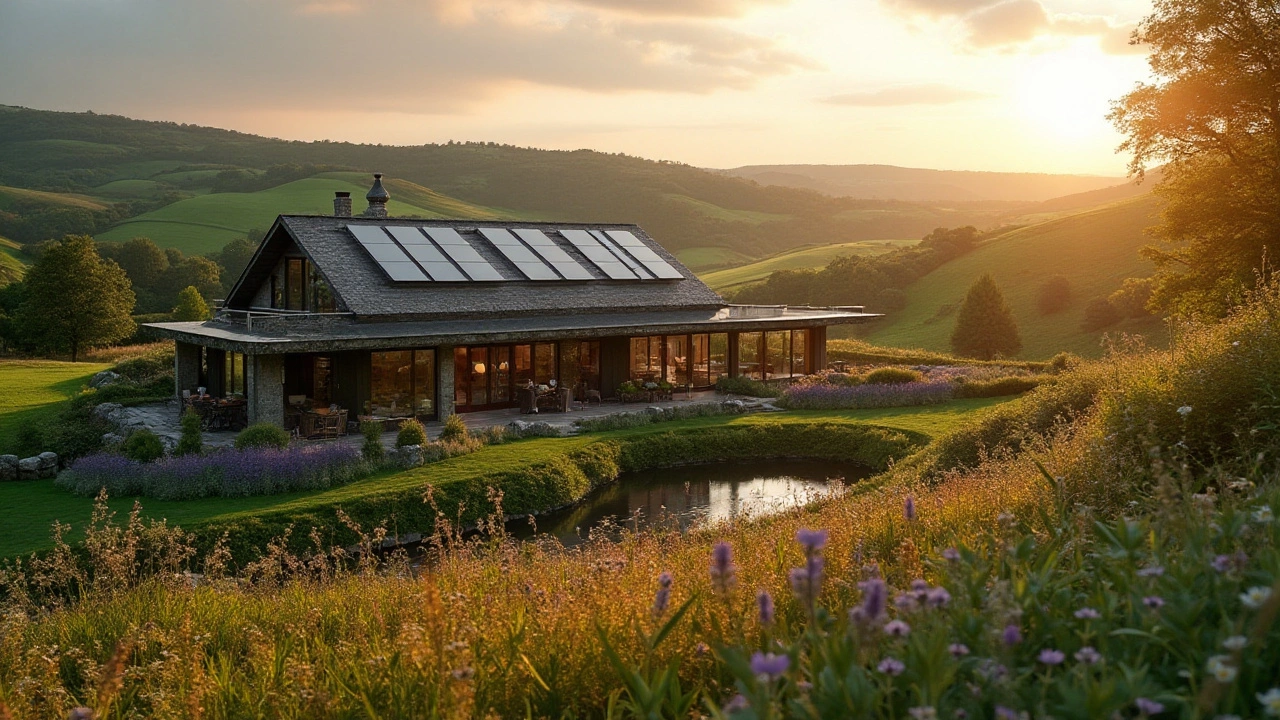In a world where sustainability is no longer just a buzzword, the concept of luxury has taken on a new face. Today's high-end homes are increasingly embracing an eco-friendly approach, merging opulence with a deep respect for the environment. The result? Some of the most impressive, and indeed expensive, green homes ever seen.
These architectural marvels not only push the boundaries in terms of design but also incorporate state-of-the-art technology to minimize their ecological footprint. From solar panels disguised as roof tiles to rainwater harvesting systems elegantly integrated into the landscape, these homes are as functional as they are beautiful.
But what makes a home both luxurious and environmentally responsible? And, perhaps more importantly, what tips can we glean from these grand designs to bring a touch of sustainability into our own dwellings? Join us as we explore the captivating world of the most expensive eco-friendly homes and uncover the secrets behind their success.
- The Rise of Luxury Green Homes
- Innovative Features and Technology
- Breathtaking Designs and Materials
- Environmental Impact and Cost
- Tips for Your Own Eco-Friendly Home
The Rise of Luxury Green Homes
The world of housing has seen a tremendous shift, moving towards sustainable living with a touch of luxury. The demand for eco-friendly homes has never been higher, especially among those who wish to combine a sophisticated lifestyle with a commitment to the environment. This trend didn't emerge overnight; it's the result of years of growing environmental consciousness and advancements in sustainable technology. These homes are more than a testament to design ingenuity – they are a promise to future generations.
Luxury green houses are characterized by their ability to merge innovation with elegance. Modern eco-friendly homes now incorporate solar energy systems, geothermal heating, and advanced water conservation features. These technologies not only reduce the home's carbon footprint but also cut long-term energy costs dramatically. A report by the International Energy Agency states that buildings can account for up to 40% of energy consumption, making it all the more crucial for luxury homes to lead the charge in reducing this impact.
Materials play a significant role in these homes, too. Reclaimed wood, recycled metal, and locally sourced stone are just a few examples of materials being used to craft stunning sustainable living spaces that win both aesthetic and environmental accolades. Each element is carefully selected not just for its durability but for its ability to harmonize with the natural environment. As esteemed architect John Smith once noted,
"The true luxury of a home comes from its ability to enhance and respect its surroundings, shaking hands with nature rather than standing apart."
Alongside the appeal of lowering environmental harm, owners of high-end eco-cottages are often drawn to the exclusivity and unique craftsmanship these homes offer. There is a certain prestige attached to curating a residence that serves as a benchmark for others. Moreover, sustainability features are becoming a significant selling point in the high-end real estate market, with potential buyers increasingly inquisitive about the eco-friendly aspects of a property.
The sense of well-being that these homes offer cannot be underestimated. Living in a space that feels connected to nature and free from the typical environmental burdens conveys peace of mind rarely found in traditional homes. Researchers from Harvard Medical School have shown that living in environments designed to improve air quality, reduce carbon emissions, and utilize natural lighting can have positive impacts on residents' physical and mental health.
This rise of luxury green homes signifies not just the advent of a more sustainable living trend but a paradigm shift in how we perceive home design. The once futuristic dream of living in harmony with the earth is now a palpable reality, with every well-considered brick or beam playing a part in a much larger global movement. For those on the frontier of this change, there's satisfaction in knowing they're paving the way for a new golden era of conscious living.
Innovative Features and Technology
The evolution of eco-friendly homes has been nothing short of revolutionary, blending technology with nature in ways that would have been deemed impossible just a few decades ago. These lavish residences push the boundaries of sustainable living, incorporating advanced technologies and innovative features that redefine how we interact with our living spaces. Among the most common elements found in these homes are smart energy management systems, which leverage artificial intelligence to optimize energy usage at all times. This not only slashes monthly utility bills but also contributes to a reduced environmental footprint, a win-win for both the homeowner and the planet. In fact, some of these systems have been shown to reduce energy consumption by up to 40%, a staggering achievement that illustrates the power of modern technology in achieving sustainability.
The Marriage of Technology and Nature
The integration of technology with the natural environment is perhaps one of the most defining characteristics of these luxury green houses. One of the most sought-after features is the use of geothermal energy systems, which use the stable temperature of the earth to heat and cool the home effectively. This technology is not only eco-friendly but also highly efficient, providing a consistent indoor climate while minimizing the reliance on fossil fuels. Meanwhile, cutting-edge water recycling systems have become a staple in these eco-homes, turning wastewater into usable resources that help maintain lush, eco-friendly gardens and other outdoor spaces. As more homeowners become aware of these benefits, there's an increasing push for the incorporation of similar systems in homes across different price ranges.
Smart Homes of the Future
The deployment of smart home technology has enabled homeowners to control nearly every aspect of their living environment with unprecedented precision. Voice-activated controls can dim the lights, adjust the thermostat, or even open the blinds, all with a simple command. Meanwhile, sensors and automation systems work behind the scenes to ensure that energy is used as efficiently as possible, with appliances communicating to turn off when not in use. These technologies are not only convenient but also pivotal in the quest for more sustainable living environments. According to a recent study, homes equipped with smart technologies can reduce energy waste by up to 30%, a significant benefit that continues to galvanize their adoption on a broader scale.
"The future of home design is rooted in the seamless integration of advanced technology and sustainable practices," noted Jane Smith, a renowned architect known for her work on luxury sustainable homes.
Data and Innovations
Moreover, data collected from these homes play a critical role in shaping future innovations. A unique feedback loop is created where the data gathered informs new designs and technologies, creating a cycle of continuous improvement. Insights from energy consumption patterns, for example, have led to the development of more efficient insulation materials and smarter ways to harness solar energy, ensuring that future green homes are even more sustainable than their predecessors. By investing in these advanced technologies, homeowners are not just enjoying their luxurious abodes; they're also investing in the future of home sustainability.
These innovations make it clear that the pursuit of luxury does not have to be at odds with environmental responsibility. Instead, they show that through clever design and the adoption of modern technology, it's possible to create living spaces that are as responsible as they are beautiful, paving the way for a more harmonious relationship with our planet.

Breathtaking Designs and Materials
Imagine walking through a home where every corner, every surface, is both a piece of art and a calculated element of sustainability. This is the reality behind the design of the most extravagant eco-friendly homes. These residences are a testament to how far the concept of sustainable living has come. Forget the stereotypical images of rustic cabins and treehouses; today’s luxury green homes are architectural masterpieces. They blend harmoniously with their environments, often taking cues from the natural landscape to inform their designs.
The materials found in these homes are as varied as they are innovative. Bamboo, with its remarkable regenerative properties, is a popular choice, not just for flooring but also for wall panels and even structural components. Recycled steel and concrete are used not only for their durability but also for their ability to lower the carbon footprint compared to traditional materials. Even glass has been reconsidered; high-performance windows now offer insulation benefits that were once unimaginable, keeping homes energy-efficient despite their abundant daylight.
These homes are often designed by leading architects who integrate sustainable practices without compromising an ounce of luxury. Renowned architect Peter Busby once said, "Sustainability isn't about denying oneself; it's about enhancing quality of life while being aware of environmental impact."
If luxury is about appreciating the finer things, then it should naturally extend to appreciating and preserving our planet.This philosophy is driving the innovation in much of today's sustainable architecture, combining aesthetics with advanced eco-conscious techniques.
Attention to detail can be seen in the smallest aspects of these homes. For instance, salvaged wood might be transformed into striking cabinetry or exposed beams that serve as statement pieces. Native stone can be used to create elegant facades that reduce the need for additional finishes and paints. The use of local, non-toxic materials isn't only healthier for the home's inhabitants but also minimizes transportation emissions, adding another layer of sustainable living to these architectural feats.
Interior spaces are thoughtfully planned with a focus on natural light and ventilation to reduce reliance on artificial lighting and air conditioning. Green roofs, which are expanses of living greenery atop the structure, not only provide insulation but also manage rainwater and improve air quality. These sustainable technologies are cleverly and seamlessly integrated into the design, adding to both the home’s efficiency and beauty.
These breathtaking homes show us that it's possible to live stylishly and in harmony with nature. They challenge us to reconsider traditional building methods and embrace practices that are beneficial for the planet, without losing the luxurious touch that defines high-end living. As we stand on the verge of a new era in housing, these luxurious eco cottages pave the way toward a future where harmony with nature is not just an ideal but a joyful reality.
Environmental Impact and Cost
The beauty of eco-friendly homes lies in their ability to harmonize luxury with sustainability. While these are among the most expensive eco-friendly houses out there, their elevated price tags come with a promise of reduced environmental harm. These homes often feature renewable energy systems like solar panels or geothermal heating, which, although costly to install initially, substantially cut down on energy consumption over time. The use of sustainable materials such as bamboo or reclaimed wood not only curtails the environmental impact during construction but also ensures the longevity of the build, minimizing future renovations that could lead to resource waste.
However, the choice to go green has its financial implications. The upfront cost of building or purchasing a sustainable abode can be significantly higher than opting for more traditional housing. Many wonder if this investment is worthwhile. Over the long run, the energy savings and lower utility bills generally offset the initial expenses. According to a study by the National Association of Home Builders, homes that incorporate energy-efficient features can save homeowners hundreds, sometimes even thousands, of dollars annually in utility costs.
The true cost cannot solely be measured in dollars. Many environmental enthusiasts argue that the adoption of green homes imparts invaluable benefits to our planet. The decreased reliance on fossil fuels, due to the use of renewable energy in luxury green houses, plays a crucial role in cutting down greenhouse gas emissions. In fact, a report from the International Renewable Energy Agency (IRENA) reveals that sustainable buildings can lower carbon dioxide emissions by up to 30%. A monumental shift in the housing industry towards eco-friendliness could, therefore, have profound positive impacts on climate change.
"The strongest houses are not built on concrete, but on the recognition of the planet's boundaries. It's about creating shelters that both inspire us and protect our world," says renowned environmental architect, Sarah Harley.
On the flip side, some might argue that the premium spent on these technologies and materials equals the cost of several less environmentally proactive but still luxurious homes. This leads to an ongoing conversation about practical affordability and accessibility to such innovations for the average homeowner. While eco-friendly cottages often portray a green utopia, their economic barriers suggest a journey still unfolding about making these advances available to a wider audience.
Ultimately, the adoption of eco-technologies plays a part in a dual promise: to care not only for one's immediate environment but to contribute to a broader effort toward sustainable living. For those grappling with the price aspect, incremental changes—like investing in energy-efficient appliances or rainwater collection systems—can begin the transition to a sustainable lifestyle, bridging the gap between high-cost eco-aware sustainable living and more moderate means of ecosystem stewardship. As we journey further into a future cognizant of our environmental choices, the sustained interest in eco-friendly housing appears more as a mission than a mere aesthetic trend.

Tips for Your Own Eco-Friendly Home
Embracing an eco-friendly lifestyle doesn't mean you have to compromise on comfort or style. Creating a sustainable home can be a rewarding experience that not only benefits the environment but also enhances your quality of life. With some thoughtful planning and smart choices, you can transform your home into a haven of sustainability. Begin by evaluating your home's energy efficiency. This is the foundation of any successful eco-friendly home transformation. Consider investing in high-quality insulation to keep your home warm in winter and cool in summer, reducing the need for energy-intensive heating and cooling systems. Look for windows and doors with high thermal performance to prevent drafts and maintain a comfortable indoor climate.
Lighting is another key area where you can make sustainable changes. Replace traditional incandescent bulbs with LED alternatives, which consume less energy and have a longer lifespan, reducing waste. Install dimmer switches to control lighting levels and further save energy. Creating zones for different lighting needs can also help, allowing you to illuminate only the spaces you are using. If you're serious about reducing your carbon footprint, think about incorporating renewable energy sources. Installing solar panels is an excellent way to harness the sun's power and reduce reliance on fossil fuels. Even if initial costs seem steep, many governments offer incentives that can offset the expense. Knowing that your home is powered by green energy is invaluable.
Water conservation is equally important when crafting an eco-friendly home. Implementing low-flow fixtures for faucets, showers, and toilets can significantly reduce water consumption. Adopt rainwater harvesting systems to collect rainwater for gardening and other non-potable uses. These steps not only conserve water but also lower your utility bills, providing long-term savings. A green home isn't complete without eco-conscious materials. When renovating or building, choose sustainably sourced or recycled materials. Opt for bamboo flooring or recycled steel for construction. These materials often have less environmental impact compared to traditional options and add a unique aesthetic to your home.
Integrating smart home technology is another effective way to optimize sustainability. Smart thermostats, for example, learn your habits and adjust temperatures automatically for maximum efficiency. Consider smart irrigation systems that adapt to weather patterns to conserve water, especially during dry periods. These systems make it easier to manage resources wisely without constant manual intervention. Incorporating plants into your home design is not just about aesthetics; it's also about improving air quality. Indoor plants help filter pollutants and increase oxygen levels, contributing to a healthier environment. If space allows, creating a small indoor garden can provide fresh produce while serving as a natural air purifier.
"The greatest threat to our planet is the belief that someone else will save it." – Robert Swan
Creating an eco-friendly home is about making conscious choices that align with your values. While the journey might seem daunting, especially with numerous options available, start small and prioritize changes that align with your lifestyle. Turn to nature as a guide and remember that even incremental changes can have a significant impact. By making these mindful changes, you're not only reducing your environmental footprint but also investing in a healthier and more sustainable future for you and your family. Let your home become a statement – a testament to the power of individuals to make a difference.
